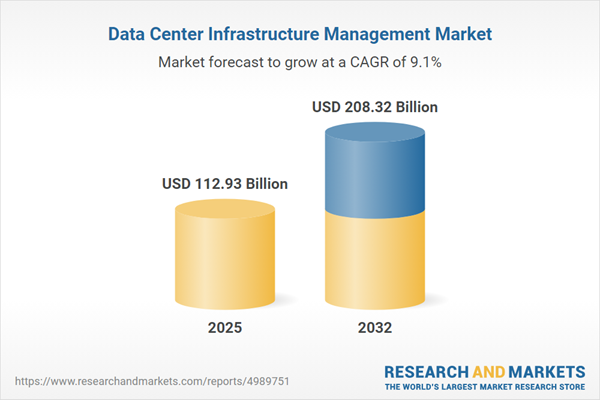Speak directly to the analyst to clarify any post sales queries you may have.
Data Center Infrastructure Management (DCIM) is rapidly redefining how enterprises oversee and optimize their critical IT and facility assets, aligning operational objectives with the evolving needs of modern digital business environments.
Market Snapshot: Data Center Infrastructure Management Market
The Data Center Infrastructure Management Market expanded from USD 103.98 billion in 2024 to USD 112.93 billion in 2025 and is projected to continue advancing at a CAGR of 9.07%, expected to reach USD 208.32 billion by 2032. This growth reflects the market's robust momentum, driven by greater integration of predictive analytics, digital transformation initiatives, and enterprise focus on sustainability. Across regions, North America leads with sophisticated AI-driven DCIM adoption, while emerging economies focus on modular and cost-effective deployments.
Scope & Segmentation
This report provides a comprehensive examination of the DCIM market by analyzing essential segments, regional markets, and competitive dynamics. Key segmentation categories include:
- Component: Hardware, Cooling Systems, Networking Equipment, Consulting, Installation Services, Maintenance Services, Management Software, Monitoring Software, Security Software
- Technology: Active Cooling, Passive Cooling, Battery Solutions, Generators
- Data Center Type: Colocation, Edge, Enterprise, Hyperscale
- Data Center Size: Large-Sized, Small and Medium-Sized
- Deployment Mode: Cloud-Based, Hybrid, On-Premises
- Application: Asset Management, Energy Management, Real-Time Monitoring
- Vertical: Banking, Financial Services, and Insurance (BFSI), Energy, Healthcare, IT and Telecom, Manufacturing, Retail
- Regional Coverage: Americas (North America: United States, Canada, Mexico; Latin America: Brazil, Argentina, Chile, Colombia, Peru), Europe, Middle East & Africa (Europe: United Kingdom, Germany, France, Russia, Italy, Spain, Netherlands, Sweden, Poland, Switzerland; Middle East: United Arab Emirates, Saudi Arabia, Qatar, Turkey, Israel; Africa: South Africa, Nigeria, Egypt, Kenya), Asia-Pacific (China, India, Japan, Australia, South Korea, Indonesia, Thailand, Malaysia, Singapore, Taiwan)
- Leading Companies: 7 Layer Solutions Inc., ABB Ltd., Altima Technologies, Inc., Altron TMT Proprietary Limited, Black Box Corporation, CommScope, Inc., Cormant, Inc., Cummins, Inc., Delta Electronics, Inc., Device42 Inc., Eaton Corporation, Equinix, Inc., FNT GmbH, Fujitsu Limited, Hewlett Packard Enterprise, Huawei Technologies, Intel Corporation, IBM, ISPsystem Ltd., Johnson Controls International PLC, Mitsubishi Electric Corporation, Modius, Inc., Nlyte Software Limited, Panduit Corp., Rackwise, Inc., Schneider Electric SE, Siemens AG, Sunbird Software, Inc., Vertiv Group Corporation
Key Takeaways for Decision-Makers
- Demand for unified DCIM solutions is intensifying as organizations seek seamless oversight of power, cooling, and asset management across core, edge, and cloud environments.
- The integration of artificial intelligence and digital twins is transforming facility expansion planning, maintenance forecasting, and operational optimization.
- Regulatory compliance and sustainability are central, with enterprises prioritizing energy efficiency, renewable integration, and low-carbon cooling methods to meet environmental mandates.
- Strategic partnerships and market consolidation are fostering end-to-end solutions, bridging traditional infrastructure silos for improved interoperability and analytics capabilities.
- Edge data center deployments are accelerating, especially in sectors like healthcare and retail, requiring advanced, scalable, and modular DCIM platforms.
- Service segments, especially consulting and maintenance, are gaining prominence as companies look for expert guidance and long-term support to ensure operational resilience.
Assessing Tariff Impact on Data Center Infrastructure Management
Cumulative United States tariffs on key components have created significant cost challenges, impacting procurement strategies and elevating the emphasis on sourcing diversification and onshoring. Modular and software-defined infrastructure approaches have emerged as strategies to contain capital expenditure and mitigate financial risk, making agile adaption and scenario planning essential for organizations with global operations.
Methodology & Data Sources
This report leverages primary interviews with infrastructure and facility leaders, complemented by secondary data from industry publications, regulatory filings, and technical whitepapers. Data triangulation and iterative peer review processes ensure analysis reliability and actionable insight integrity.
Why This Report Matters
- Provides clarity on navigating evolving technology, regulatory landscapes, and market drivers to inform risk mitigation and investment strategies.
- Enables executive teams to benchmark DCIM adoption, operational best practices, and strategic positioning based on empirical evidence and expert perspectives.
Conclusion
This executive assessment empowers decision-makers with granular insights on infrastructure modernization, operational risk, and innovation levers essential for sustainable, efficient, and future-ready data center infrastructure management.
Additional Product Information:
- Purchase of this report includes 1 year online access with quarterly updates.
- This report can be updated on request. Please contact our Customer Experience team using the Ask a Question widget on our website.
Table of Contents
3. Executive Summary
4. Market Overview
7. Cumulative Impact of Artificial Intelligence 2025
Companies Mentioned
The companies profiled in this Data Center Infrastructure Management market report include:- 7 Layer Solutions Inc.
- ABB Ltd.
- Altima Technologies, Inc.
- Altron TMT Proprietary Limited
- Black Box Corporation
- CommScope, Inc.
- Cormant, Inc.
- Cummins, Inc.
- Delta Electronics, Inc.
- Device42 Inc.
- Eaton Corporation
- Equinix, Inc.
- FNT GmbH
- Fujitsu Limited
- Hewlett Packard Enterprise Development LP
- Huawei Technologies Co. Ltd
- Intel Corporation
- International Business Machines Corporation
- ISPsystem Ltd.
- Johnson Controls International PLC
- Mitsubishi Electric Corporation
- Modius, Inc.
- Nlyte Software Limited
- Panduit Corp.
- Rackwise, Inc.
- Schneider Electric SE
- Siemens AG
- Sunbird Software, Inc.
- Vertiv Group Corporation
Table Information
| Report Attribute | Details |
|---|---|
| No. of Pages | 184 |
| Published | November 2025 |
| Forecast Period | 2025 - 2032 |
| Estimated Market Value ( USD | $ 112.93 Billion |
| Forecasted Market Value ( USD | $ 208.32 Billion |
| Compound Annual Growth Rate | 9.0% |
| Regions Covered | Global |
| No. of Companies Mentioned | 30 |









